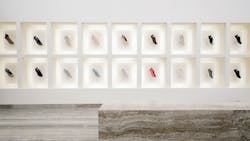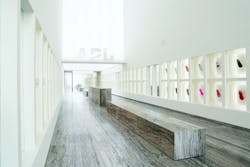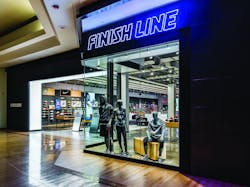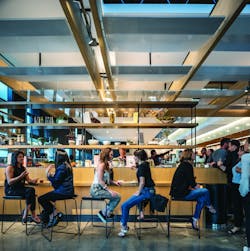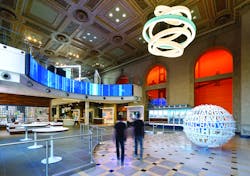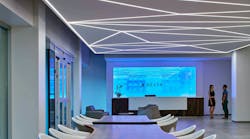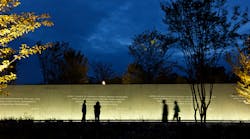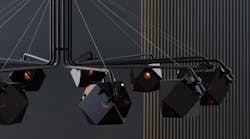“E-commerce is booming, but physical stores remain important. Forward-thinking companies have been using their stores to educate consumers, reinforce their brands’ positioning, and support e-commerce sales,” said Archit Jain, principal and partner of Oculus Light Studio. Creating interior environments that are social media-ready and flattering are two cornerstones to achieving success in this dual in-person/online retail strategy—and both require special consideration where the lighting is concerned.
Jain is exceptionally well-versed in what retailers want. His award-winning architectural lighting design firm has completed several impressive retail projects, including the AT&T Store of the Future and flagship locations for both Nike and Athletic Propulsion Labs in Tokyo and Los Angeles, respectively.
Retail clients are putting high priority on the “Instagrammable Moment.” This phenomenon connects consumers’ digital and physical worlds and enables retailers a greater reach than their carefully honed marketing plans could imagine. According to a VidMob study, The State of Social Video, “25% of Gen Z and millennials actively seek videos of products and services they may buy.”
But creating an Instagram-worthy moment is no small task. It requires both a beautiful setting that will translate when snapped and an event that inspires the customer to capture it in the first place. Lighting can certainly help set the mood.
“In all cases, the lighting has to be soft and flattering for selfies that the guests are taking in the store environment. In some instances, we have recommended backlit fabric ceilings and wall surfaces which provide that kind of light,” said Jain. “Coupled with picturesque backgrounds that are illuminated with ambient light or accent light, the in-store moments are shared on social media, increasing hype and online discussions.”
The lighting in dressing rooms is also critical in creating a comfortable and positive in-person shopping experience. “The lighting in any fitting room needs to be soft and minimize any harsh shadows,” Jain said. “Verticals on either side of the mirror (think of versions of green room mirror marquee lights) work the best. Fully illuminated globe-like luminaires, located close to the mirror, also provide soft light.” Downlights, as the only source, are not recommended.
Retailers understand the longer a customer remains in a store, the longer they continue to shop and add to their purchases. Including restaurants and cafes has long been a tradition in department and specialty retail stores. “The F&B (food and beverage) spaces are hospitality spaces and, depending on the character of the space, may be designed as fine dining or fast-food locations,” Jain points out. “The lighting design is complementary to the function of the space. If the locations are multi-functional, they may have flexible lighting systems, for instance, color changing or moving lights for events and fixed or adjustable architectural lighting for everyday use,” he added.
Here is a quick look at the way that Jain and his team brought lighting into some of retail’s greatest brick-and-mortar stores. Italicized quotes are key rules that Jain and his firm follow when designing a retail space:
Athletic Propulsion Labs, Los Angeles
For APL’s retail flagship store at The Grove, Bernard Dubois Architects created an interior where examples of the footwear line were displayed as if they were in an art gallery. Square display enclosures recessed into the wall are outlined with light to create a visual rhythm with the products. Overall illumination is provided by diffused backlit surfaces and concealed integral niche lighting without the use of spotlights.
“Light the Merchandise, whether on an open display case or counter, in recessed wall racks, or in closed cases. Many display cases no come with built-in lighting, so this has to be taken into consideration.”
Finish Line, Chicago
The lighting design for the prototype Finish Line store in Chicago was inspired by racing lanes. Oculus interpreted the outlined spaces directing competitive athletes to their goal at the race’s end with narrow LED pendants in contrast to the dark-painted ceiling. Floor and wall displays are illuminated by track heads fitted with LEDs. Architects were CallisonRTKL.
“In value stores, only ambient light is needed. For luxury stores, accent lighting can be added.”
Nike ABC-Mart Grand Stage, Tokyo
The glowing transparent grid glass façade of Nike’s Tokyo flagship is a major street presence. CallisonRTKL and Oculus worked to dramatize the store to appeal to young, style-driven customers, showing a variety of athletic specialty brands and innovative products. Assuming architectural importance is a ceiling-hung spray of extended, white-enclosed strip LEDs that fan out over the main ground-level sales space. Track lights call attention to the multi-shelf built-in display cases presenting footwear and rod-hung apparel.
Erewhon Market, Los Angeles
Linear and accent fixtures combine with overhead daylighting for the snack bar and products displayed in the deli section of this contemporary food store. Architects were Retail Design Collaborative; Montalba Architects were design architects.
“Light the perimeter walls to establish vertical illumination, so the consumer feels a frame for the space and is comfortable in exploring the displays.”
Saks Fifth Avenue, Houston
The exterior of the Houston branch of Saks Fifth Avenue at nighttime becomes an illuminated sculptural surface. Programmable LEDs in a staggered design are supported by a custom metal screen attached to the façade.
“Allow for flexibility. We spend a large chunk of time adjusting luminaires once they are installed. We also check the control settings, dimmer levels, and night light levels.”
AT&T Store of the Future, San Francisco
In Union Square, the AT&T Store of the Future is located in a building of the past. Constructed in 1921, the building was restored by CallisonRTKL architects, with lighting by Oculus, to create flexible display locations. A custom chandelier based on AT&T’s logo is the focal feature in the double-story atrium. Existing HID downlights were replaced with 3000K, 4,000 lm. LED versions, located in fill-in panels, illuminating the area below to 50fc. Under the mezzanine, 3500K 80+CRI linear recessed LED fixtures provide ambient light, while 2700K 90+CRI multi-head LED accents draw attention to tech products and accessories and bring out the warm exposed wood surfaces. Decorative pendants are illuminated by 85+ CRI LEDs.
This article appeared in the March 2022 issue of Architectural SSL magazine.
